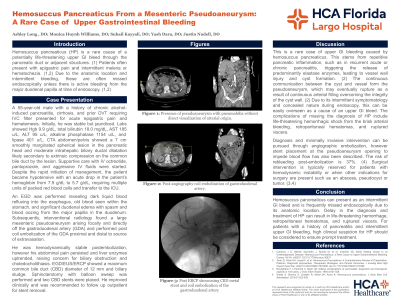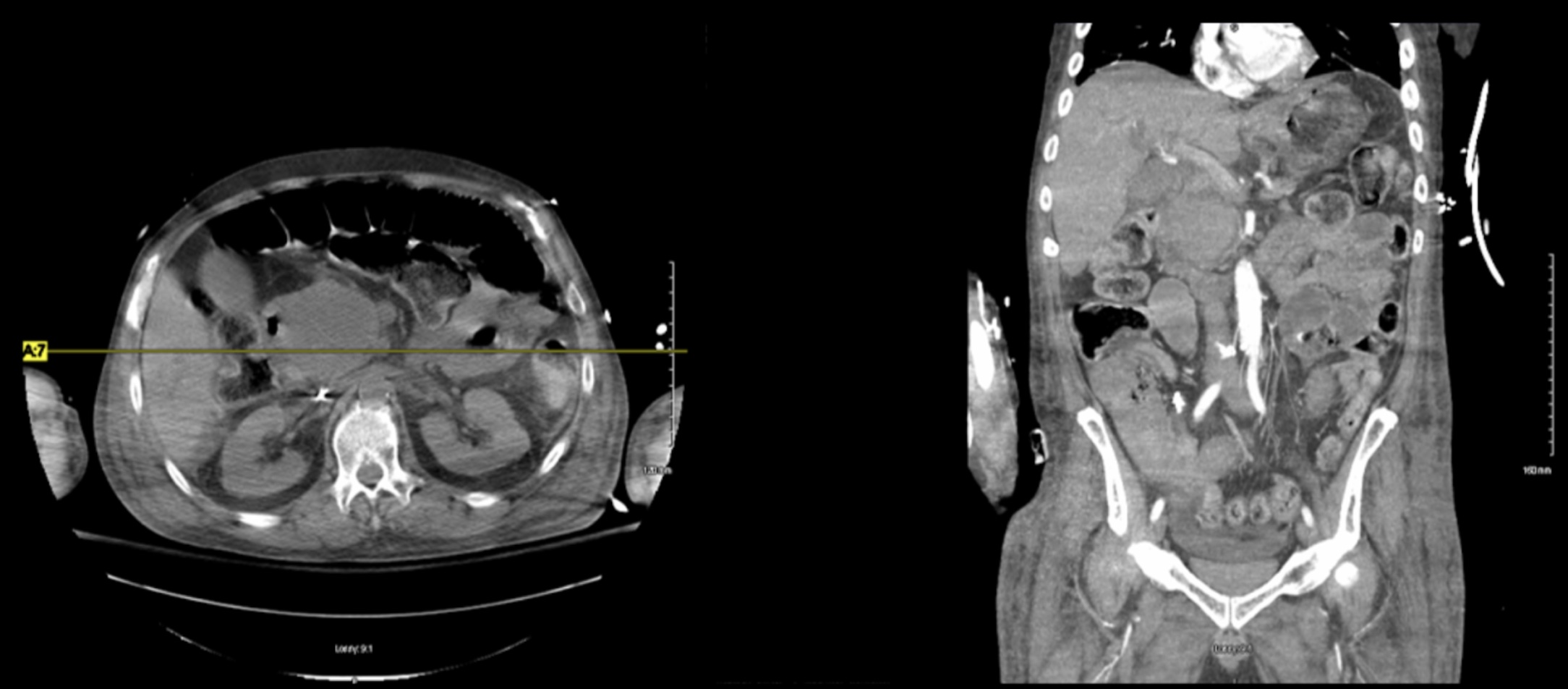Sunday Poster Session
Category: GI Bleeding
P0808 - Hemosuccus Pancreaticus From a Mesenteric Pseudoaneurysm: A Rare Case of Upper Gastrointestinal Bleeding
Sunday, October 27, 2024
3:30 PM - 7:00 PM ET
Location: Exhibit Hall E

Has Audio

Ashley Long, DO
HCA Florida Largo Hospital
Largo, FL
Presenting Author(s)
Ashley Long, DO1, Monica A. Huynh Williams, DO1, Yash Dara, DO1, Ishpaul Bhamber, DO1, Suhail Kayyali, DO2, Justin Nudell, DO1
1HCA Florida Largo Hospital, Largo, FL; 2HCA Healthcare, Largo, FL
Introduction: Hemosuccus pancreaticus (HP) is a rare cause of a brisk upper gastrointestinal (GI) bleeds through the pancreatic duct or adjacent structures as a result of pseudoaneurysms from chronic pancreatitis.1,2 Due to the anatomic location and intermittent bleeding, these are often missed endoscopically unless there is active bleeding from the major duodenal papilla at time of endoscopy.1,2 Here, we describe a case of HP that initially presented as a stable upper GI bleed, but quickly decompensated into hemorrhagic shock.
Case Description/Methods: A 55-year-old male with a history of chronic alcohol-induced pancreatitis and cirrhosis presented for epigastric pain and hematemesis. He was initially stable with a hemoglobin (Hgb) of 9.9, total bilirubin 18.0, alkaline phosphatase 1154, and lipase 401. Triphasic imaging revealed a 6 cm pancreatic pseudoaneurysm with compression on nearby structures. Despite rapid initiation of octreotide, pantoprazole and fluids, the patient developed hemorrhagic shock with acute drop in Hgb to 5.7 requiring multiple transfusions over the next few days. Endoscopy revealed blood oozing from the major papilla with an unidentifiable source. Interventional radiology discovered a large mesenteric pseudoaneurysm arising off the gastroduodenal artery and performed a successful coil embolization.
Discussion: This is a rare case of upper GI bleeding caused by HP. HP is often overseen as a cause of an upper GI bleed due to its intermittent symptomatology and concealed nature during endoscopy. Less than 2% of pseudoaneurysms from chronic pancreatitis arise from the gastroduodenal artery, with even fewer cases leading to HP. Delay in the diagnosis and treatment of HP can result in life-threatening hemorrhagic shock from brisk arterial bleeding, retroperitoneal hematomas, and ruptured viscera.2 High clinical suspicion for HP is crucial in patients with a history of pancreatitis and intermittent upper GI bleeding to ensure prompt treatment.
References:

Disclosures:
Ashley Long, DO1, Monica A. Huynh Williams, DO1, Yash Dara, DO1, Ishpaul Bhamber, DO1, Suhail Kayyali, DO2, Justin Nudell, DO1. P0808 - Hemosuccus Pancreaticus From a Mesenteric Pseudoaneurysm: A Rare Case of Upper Gastrointestinal Bleeding, ACG 2024 Annual Scientific Meeting Abstracts. Philadelphia, PA: American College of Gastroenterology.
1HCA Florida Largo Hospital, Largo, FL; 2HCA Healthcare, Largo, FL
Introduction: Hemosuccus pancreaticus (HP) is a rare cause of a brisk upper gastrointestinal (GI) bleeds through the pancreatic duct or adjacent structures as a result of pseudoaneurysms from chronic pancreatitis.1,2 Due to the anatomic location and intermittent bleeding, these are often missed endoscopically unless there is active bleeding from the major duodenal papilla at time of endoscopy.1,2 Here, we describe a case of HP that initially presented as a stable upper GI bleed, but quickly decompensated into hemorrhagic shock.
Case Description/Methods: A 55-year-old male with a history of chronic alcohol-induced pancreatitis and cirrhosis presented for epigastric pain and hematemesis. He was initially stable with a hemoglobin (Hgb) of 9.9, total bilirubin 18.0, alkaline phosphatase 1154, and lipase 401. Triphasic imaging revealed a 6 cm pancreatic pseudoaneurysm with compression on nearby structures. Despite rapid initiation of octreotide, pantoprazole and fluids, the patient developed hemorrhagic shock with acute drop in Hgb to 5.7 requiring multiple transfusions over the next few days. Endoscopy revealed blood oozing from the major papilla with an unidentifiable source. Interventional radiology discovered a large mesenteric pseudoaneurysm arising off the gastroduodenal artery and performed a successful coil embolization.
Discussion: This is a rare case of upper GI bleeding caused by HP. HP is often overseen as a cause of an upper GI bleed due to its intermittent symptomatology and concealed nature during endoscopy. Less than 2% of pseudoaneurysms from chronic pancreatitis arise from the gastroduodenal artery, with even fewer cases leading to HP. Delay in the diagnosis and treatment of HP can result in life-threatening hemorrhagic shock from brisk arterial bleeding, retroperitoneal hematomas, and ruptured viscera.2 High clinical suspicion for HP is crucial in patients with a history of pancreatitis and intermittent upper GI bleeding to ensure prompt treatment.
References:
Cardona J D, Beltrán Saavedra J, Rueda M, et al. (October 29, 2022) Getting Closer to an Underdiagnosed Disease: Hemosuccus Pancreaticus, a Rare Cause of Upper Gastrointestinal Bleeding. Cureus 14(10): e30837. DOI 10.7759/cureus.30837- Tarar ZI, Khan HA, Inayat F, et al. Hemosuccus Pancreaticus: A Comprehensive Review of Presentation Patterns, Diagnostic Approaches, Therapeutic Strategies, and Clinical Outcomes. J Investig Med High Impact Case Rep. 2022;10:23247096211070388. doi:10.1177/23247096211070388

Figure: Figure 1: Axial (left) and coronal (right) views from computerized tomography of the abdomen and pelvis revealing pseudoaneurysm with pneumobilia without direct visualization of arterial origin.
Disclosures:
Ashley Long indicated no relevant financial relationships.
Monica Huynh Williams indicated no relevant financial relationships.
Yash Dara indicated no relevant financial relationships.
Ishpaul Bhamber indicated no relevant financial relationships.
Suhail Kayyali indicated no relevant financial relationships.
Justin Nudell indicated no relevant financial relationships.
Ashley Long, DO1, Monica A. Huynh Williams, DO1, Yash Dara, DO1, Ishpaul Bhamber, DO1, Suhail Kayyali, DO2, Justin Nudell, DO1. P0808 - Hemosuccus Pancreaticus From a Mesenteric Pseudoaneurysm: A Rare Case of Upper Gastrointestinal Bleeding, ACG 2024 Annual Scientific Meeting Abstracts. Philadelphia, PA: American College of Gastroenterology.
